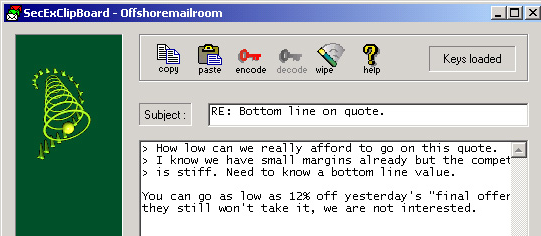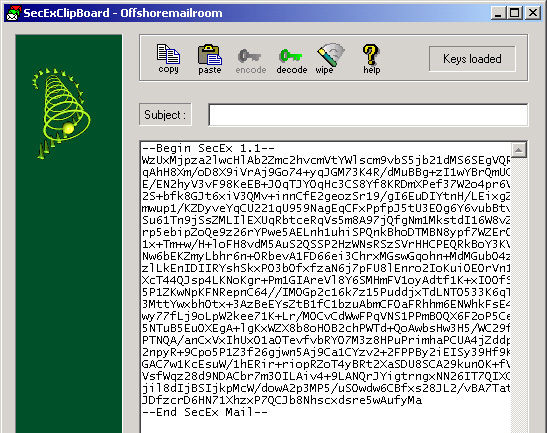SecExClipboard is designed primarily to be a travel-mate for SecExMail users. It's small size allows it to be stored on a floppy disk and carried anywhere. When reading or writing email from an internet café, while away from your home or office computer, SecExClipboard allows you to maintain your privacy. Like SecExMail, it implements open standard encryption algorithms to protect the privacy of your email on the public internet. SecExClipboard is compatible with SecExMail so any messages you send to a recipient who uses SecExMail will be readable to them.
How SecExClipboard works :
The images below show a message typed into SecExClipboard, before and after encryption with the recipient's public key. Note: The subject will appear as the email subject when the recipient receives the message.
| Image above: Clear text message typed directly into SecExClipboard.
|
| Once encoded, the cypher text appears and can be copied to the clipboard and later to a web-based mail system for sending to the recipient.
|
General Features :
| SecExClipboard is one file. When you are going to be on the road, copy SecExClipboard to a floppy disk and export your SecExMail keys to the same floppy disk. That's it.
|
Technical Features :
| SecExClipboard uses standard RSA based public key encryption. Supported key sizes are 2048, 4096 and 8192 bits ( up to 10240 bits for offshore edition and corporate edition ). Two messages are never encrypted with the same session key. Instead the public key associated with the recipient of a message is used to encrypt a random session key which is used to encrypt the message. Generation of strong session keys is based on a sophisticated entropy collection system.
|
| Individual messages are double encrypted via 64 bit ISAAC and 256 bit Twofish encryption .
|
| · | Coexistence with other encryption standards
|
| SecExClipboard encrypts data and therefore does not interfere with existing methods of encryption. As such, it is possible to encrypt with PGP or GPG first, and then send the resulting cipher text through SecExClipboard for further encryption. On the remote end, the recipients SecExMail or SecExClipboard restores the PGP cipher text which can then be decrypted by the user's email client or associated PGP decryption module.
|
|
|

